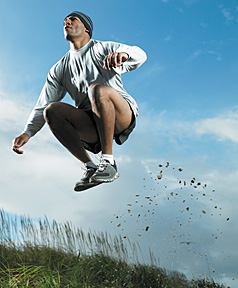Jump Into Better Health: The Power of Plyometrics
By Dr. Jeffrey Tucker
Want to run faster, jump higher, move quicker and get in better shape, all at the same time? If you're answer is yes, it's time for a lesson in
plyometrics. Exercises based on plyometrics repeatedly and rapidly stretch muscles and then contract them, improving muscle power. And don't we all want a little more muscle power, whether it helps us compete in our favorite sport or just perform our daily physical activities a little easier? Here's your introduction to plyometrics and a sample routine you can do
today.
I recall being in awe watching Jamaican sprinter Usain Bolt flash across the finish line at the 2008 Summer Olympics in Beijing and being so impressed with his speed and ability. I continue to be amazed at top basketball players, tennis players, football players, and other athletes as they jump up in the air repeatedly, skillfully maneuver their arms and legs while airborne, land on a small portion of one or both feet, and then move immediately to the next position - all without falling (usually). I shake my head and say to myself, "Now that is power!" One of the best ways to develop this type of power is through plyometric training.
 Plyometric training is used to produce fast, powerful movements and improve the function of the nervous system for explosive power. This helps you create muscular movements in the shortest period of time and is especially beneficial to sprinters and athletes who need to accelerate quickly. Plyometric movements train the muscle to load, unload and then reload in rapid sequence, allowing you to jump higher, run faster, throw farther or hit harder, depending on the desired training goal. In short, plyometrics help us improve our speed because we train the body to jump and land with speed.
Plyometric training is used to produce fast, powerful movements and improve the function of the nervous system for explosive power. This helps you create muscular movements in the shortest period of time and is especially beneficial to sprinters and athletes who need to accelerate quickly. Plyometric movements train the muscle to load, unload and then reload in rapid sequence, allowing you to jump higher, run faster, throw farther or hit harder, depending on the desired training goal. In short, plyometrics help us improve our speed because we train the body to jump and land with speed.
If you are active and work out, and you want to stay healthy and even perform faster and better, then plyometric exercises that involve jumping, hopping, leaping and skipping can help you achieve your fitness goals. Plyometric exercise is based on the understanding that a concentric (shortening) muscular contraction is much stronger if it immediately follows an eccentric (lengthening) contraction of the same muscle. Imagine stretching out a coiled spring to its fullest extent, and then letting it go: immense levels of energy are released in a split second as the spring recoils.
The most important part of a plyometric program is developing landing skills. Reducing force is just as important as generating it. Injuries rarely occur during take-off, but a considerable amount of injuries occur because you can't decelerate quickly enough. I'll be describing some exercises that develop this recoil.
Getting Started: What You Need
Common plyometric exercises include jumping rope, squat jumps, lunge hops, overhead medicine ball tosses, medicine ball chest passes, and jumping jacks. Plyometric training starts with body-weight exercises for beginners; more advanced athletes can use equipment such as dumbbells, boxes, medicine balls, hurdles and elastic cords - any of these can make an exercise more challenging.
A bench or step-up box can be used to improve explosive power and overall speed, allowing you to perform single- or double-leg exercises. Using a step-up box allows you to perform forward jumps and lateral (side-to-side) jumps. Hurdle steps can be used to perform power jumps, high-knee drills, and explosive runs.
I've also used tubing anchored to weight plates or cables and the other end attached to the athlete. The base serves as an anchor while the athlete performs forward, backward, lateral, vertical or jumping movements.
By the way, before you try any of the following exercises, keep in mind the following distinctions concerning terminology. First, a jump and a hop are not the same thing. A jump is two legs to two legs. A hop is right leg to right leg or vice versa. Hopping must be done forward, medially and laterally. Here's another one to remember: A bound is right leg to left leg; a skip is two foot contacts per foot.
Your Beginning Plyometric Program: Progress Through the Three Phases
Phase 1 starts with jumping up onto a box or bench. This is not really a "true" plyometric, but it teaches jumping and landing skills with stability and introduces the elastic component of jumping. This phase should be practiced for a minimum of three weeks. Do three to five sets of five jumps, two days per week. In phase 2 we jump or hop over an object. This increases the workload and incorporates a further selection of dynamic exercises before upping the intensity in stage three by using a combination of running drills. In phase 3, a bounce is added. This is where we learn to minimize time spent on the ground.
For jumps (using both legs), do three to five sets of five jumps per set. For single-leg plyos, try for a total of 15 jumps per leg (all sets).

